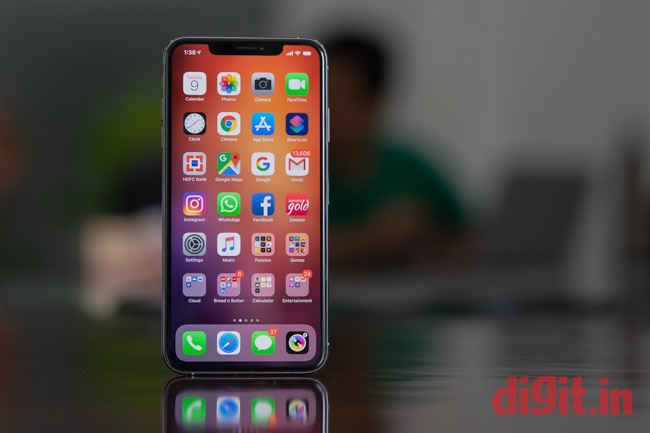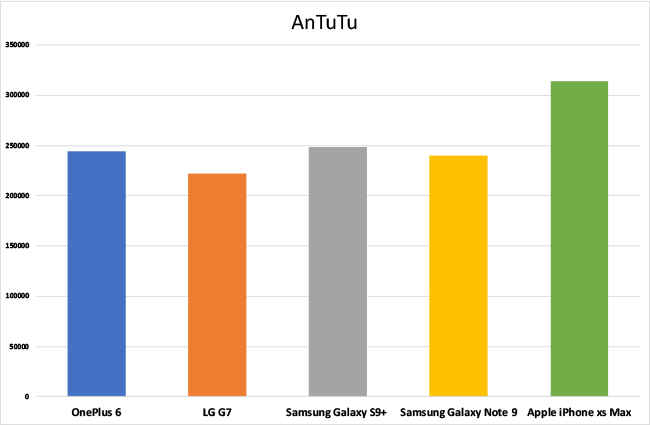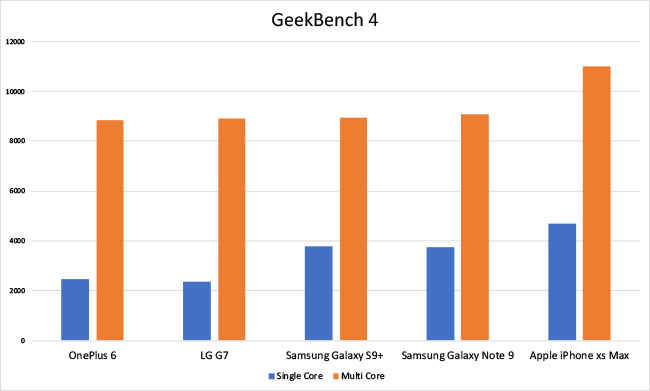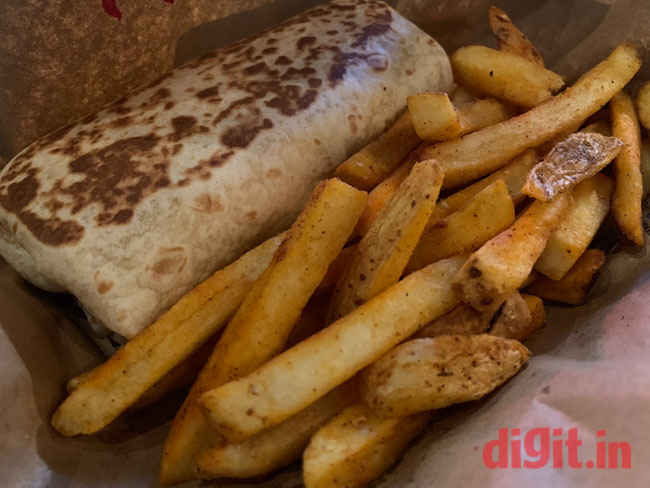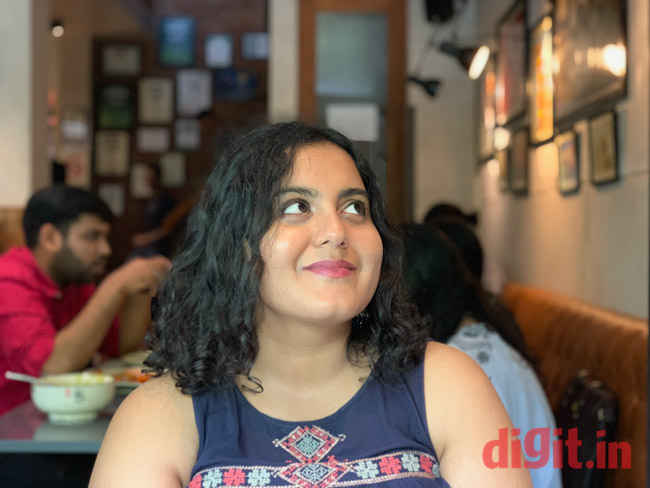Apple iPhone XS Review : Brilliance at a huge price
The Apple iPhone XS is powered by an impressively fast A-12 Bionic chip, features an HDR10 and Dolby Vision certified display and continues to take great photos and videos. However, the iPhone XS with its average battery life and the astronomical price isn't a smartphone for everyone.
Build and Design
The iPhone XS, just like the iPhone XS Max, is constructed using two panes of the strongest glass “Apple has ever used in a smartphone” sandwiched using “surgical grade” stainless steel. There’s no actual clear definition of what constitutes “surgical grade stainless steel,” except that it should be corrosion resistant. It sure does sound fancy though. The glass front and back are fairly resistant to fingerprint smudges though, more than most flagships in my experience, so that is good. The iPhone XS is 5.65 inches tall and 2.79 inches wide. For someone like me who has average sized hands, the phone is easy to hold and use, even with a single hand. I put the phone in a case soon after it was set up and even though that adds a few millimetres of bulk to the overall width and thickness, its one-handed usability is not impacted.
Part of the built quality of the iPhone XS is its IP68 rating and the additional claims of Apple having tested the phones against common liquids such as coffee, beer, juice etc. We dunked our review unit of the iPhone XS Max into a bowl full of water, Pepsi, coffee and even Mazaa for extended periods of time, yet the phone continued to work. There is no reason to doubt that the iPhone XS will have the same level of resistance to liquids, although we strongly recommend not abusing the limits of how far the iPhone can go. But its safe to assume that the phone will easily withstand accidental spills and the occasional push into the pool.
When it comes to design, you will be hard pressed to find any differences between this year’s iPhone XS and last year’s iPhone X. The two phones utilize identical external design and as such if you do buy the phone, don’t expect anyone to know you’re holding the newer of the two phones unless you get the new gold variant. We received the Space Gray variant, which is identical to the last year’s model. In fact, most cases that were made for the iPhone X will be usable on the iPhone XS as well. However, there has been a very tiny change in the size of the camera module so ‘some’ cases may not fit snug against the camera bump.
Overall, the design of the iPhone XS is the same as last year’s and its one of those “take it or leave it” situations. I don’t mind the same design honestly, because if there is anything I have realized, it’s that the iPhone XS is very easy to use with one hand.
Display – Love at First Sight
The iPhone XS features a 5.8-inch bezel-less display, fitted into a 5.65-inch form-factor thanks to the 19.5:9 aspect ratio. The display sports an unconventional resolution of 1125×2436 which puts the display’s pixel density at roughly 458 ppi. But you don’t really need to care about that.
What you should care about is that the OLED panel that comprises the iPhone XS’s display is one of the best displays on a smartphone. It supports HDR10 like last year, but this year also gains Dolby Vision certification. It is a beautiful display whether it is for consuming content or creating it. The display is surprisingly accurate even with True Tone enabled. Content is easily visible even in bright daylight and if you’re in bed, you can dim the display all the way to 2 nits for an easy viewing experience in pitch dark.
OLED panels inherently are absolutely beautiful two looks at, but they do have 2 problems. The first is the problem of ghosting and isn’t too much of a concern at this point. The second is the colour shift that OLED panels exhibit which was markedly horrible in the Pixel 2XL. This colour shift appears when the phone is held off-axis from the eyes, making parts of the screen change colour from a warm tone to a blue tint, or vice-versa. The review unit of the iPhone XS we tested only showed the colour shift when the phone was held at extreme angles, which is totally normal of OLED panels.
Suffice to say, you’re getting one of the best displays in the market with the iPhone XS. However, in order to take full advantage of this display, you’re going to have access to tons of HDR content. Great if you have the premium tier of Netflix subscription or are willing to rent or buy HDR content from the iTunes store. Honestly, though, it just feels nice to view photos and even well-produced YouTube content on the iPhone XS. There’s absolutely no fault to be found with the iPhone XS display.
Performance
When it comes to performance, Apple has hit it out of the park and how. The new A-12 Bionic chip that powers the iPhone XS is a testament to big things coming in small packages. The 7nm fabrication process has allowed Apple to squeeze out big performance and decent power efficiency out of the chip. While we’ll talk about the battery in a later section, let's get to the performance numbers.
The A-12 Bionic chip allowed the iPhone XS to blaze past all other Android flagships of the year in almost every benchmark. Whether it was Geekbench 4 (4692 on single core and 10997 on multi-core) or 3DMark (3598 on Sling Shot), the iPhone XS (just like the iPhone XS Max) is far ahead of every flagship in the market right now.
What this results in is speedy performance especially when opening, closing or switching apps. Since the iPhone XS now solely relies on gestures for navigating through the user interface, the phone cannot afford to have any kind of lag. This is in addition to the fact that no matter what game or task you run on the iPhone XS, it is all going to run butter smooth.
I played Fortnite, Asphalt 9 and a bunch of indie-games like Monument Valley 2, Rings and Ridiculous Fishing without the iPhone XS so much as breaking a sweat. The iPhone XS barely got warm during 30-minute spurts of gaming sessions. Even photo editing was a breeze, including editing RAW files in Adobe Lightroom. Given that our review unit of last year’s iPhone X still works like a charm, we expect the iPhone XS with its impressively powerful A-12 Bionic chip to last a while before it starts to show signs of ageing.
Camera
Every year, the iPhone sees an improvement in its camera, but it's not every year that the changes are in both hardware and software. We still get dual sensors with 12-megapixel resolution each, with the wide 26mm lens sporting a f/1.8 aperture while the 52mm telephoto lens has an aperture of f/2.4. The hardware improvement here is the new imaging sensors, which also come with far more phase detect pixels than the previous cameras. Larger apertures would have been great to have, but Apple is compensating for that with software.
This time, we are seeing the biggest show of Apple’s use of computational photography. Apple has introduced SmartHDR a technique where the phone shoots intra-frames between the standard tri-shot that makes up an HDR photo. Then using machine learning, the ISP fuses the best parts of all the frames together to deliver the final shot. In order to test the camera on the iPhone XS, we went out and shot over 300 frames in order to determine just how well the camera actually works. Suffice to say, it left us impressed. The autofocus is definitely fast and requires little nudging to lock onto the right subject. There were two occasions where the performance took a hit; one in extremely low light and the other time when trying to focus on a plant with dense foliage. Regardless, a little re-tapping on the screen nudged the focus in the right direction.
Coming to imaging performance, daytime performance is absolutely stellar. The colours are gorgeous and the photos are generally missing the usual HDR halation that occurs under strong lighting. Details are impressive for objects that are shot up close, but landscape shots show a little loss in detail for distant objects. For example, the detail in the fur of my dog is definitely impressive, but when taking landscape shots, the leaves in the distant trees look a little smudged.
When it comes to low light situations, you can expect the iPhone XS to take good photos all the way to ISO 1600. Once the sun goes down, or you move indoors into poor lighting, the iPhone is quick to boost the ISO, especially if SmartHDR is enabled. The downside to the high ISO numbers is aggressive noise reduction which tends to smudge out more detail for anyone’s liking. Photos of people will render extremely smooth skin and if you’re shooting something colourful, there’s a chance the colour patches would end up looking like paint splotches. Turning SmartHDR off will improve performance by a little bit, but it could be the difference between a usable photo for social media versus something you wouldn’t want to put out in the world.
The Portrait Mode on the iPhone XS now features a virtual aperture control slider that will allow you to determine just how much background blur you want in the image. While the images look good for the most part, Apple’s implementation of portrait mode is still limited by distance. The subject you are shooting has to be 10 feet away and if they’re any closer, the camera app will not be able to shoot a portrait. This puts limits on the framing possibilities. However, if you do adhere to the rules, you will end up with some very impressive looking photos. The background blur is soft and if there are strong sources of light in the background, you will see circles in the bokeh. However, the subject-background separation still isn’t perfect and more often than not, you will find imperfections around the subject’s edges.
The 7-megapixel front-facing camera does a great job of taking selfies, but some users might find the 32mm field of view limiting. Regardless, the faceID hardware doubles up as a tool for enabling portrait mode for the front camera. Portrait shots from the front camera are quite pleasing and have better edge separation. Otherwise, images come out looking gorgeous with the right amount of saturation and the right kind of white balance dialed in. There’s been some controversy over an alleged beauty mode that softens the skin, but that is just not true. Yes, the skin has lesser detail than what we’ve seen on previous generation iPhones, however, this is due to SmartHDR and not because of some secret beauty mode. Because to make SmartHDR work, the ISO has to be bumped up, when the final image is processed, some noise reduction is also applied to it, causing the softening in the skin. Apple did say they are working on fixing this, but honestly, its not a deal breaker. What does work well for the front-facing camera is the optical image stabilization which comes in very handy when shooting video using the selfie camera.
You can see 100+ image samples shot from the iPhone XS and the iPhone XS Max in our Flickr Gallery.
Overall, the imaging performance of the iPhone XS is spending, scoring well into the top league. While the camera app itself offers quite a number of features, the best way to get the most out of the iPhone XS’s sensor would be by using a third party app like Halide or Camera +2.
Battery Life
Apple is known to never put high capacity batteries in their smartphones. In comparison to Android counterparts, this has always been a sore point and with the iPhone XS, things are no different. You get a 2658mAh battery which Apple claims is going to last you 30 minutes more than the iPhone X. While GeekBench’s battery test gave the iPhone XS a run time 5 hours and 35 minutes. The numbers don’t inspire confidence, but in day to day usage, the phone does manage to just about make it through a busy workday.
Having used the iPhone XS as my primary device for some time, it is safe to say that the battery life will make you stress a bit towards the end of the day. This is on days with heavy usage which involves about 4 hours of music playback, taking about 10-15 photos a day and 4 hours of phone calls. There’s also the long WhatsApp conversations so you would have a general idea of how things go during the day. Thanks to wireless charging, I am occasionally able to top the phone up a bit during the day. Suffice to say, the battery life on the iPhone XS isn’t the best in the league it competes in, so if you are going to invest in a phone this expensive, do ensure you buy a battery pack as well.
Bottomline
The iPhone XS is an absolute beast when it comes to performance. The new A-12 Bionic chip performs far beyond what the Snapdragon 845 today is capable of. The display is definitely serious eye-candy and the cameras themselves are great. What’s not so great is the battery life, and the price tag of Rs 1,34,900, which seems far too high for a smartphone. While this is definitely a powerful device, it is hard to justify spending a small car’s down-payment on a smartphone. The iPhone XS isn’t for everyone. It is for those for whom price is no object, and for those who can actually afford the price tag.
Swapnil Mathur
Swapnil was Digit's resident camera nerd, (un)official product photographer and the Reviews Editor. Swapnil has moved-on to newer challenges. For any communication related to his stories, please mail us using the email id given here. View Full Profile

